The Comprehensive Guide to Trilliant Cut Diamonds
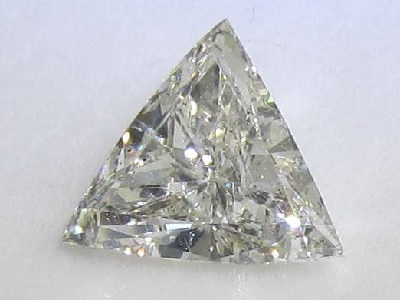
A loose 1 ct trilliant cut diamond certified by GIA.
“Trilliant” is a broad term that’s used to describe cuts based on the shape of a triangle and they are one of the most unique looking fancy shaped diamond in the market.
Typically, the trilliant diamond is cut to equivalent sides and is made up of 50 facets. They are popular amongst people who are searching for a fashionable looking stone or want an alternative shape that is different from the common round diamond.
In modern times, they are often used in diamond rings as sidestones or as accent stones to complement a main stone instead of a standalone solitaire. Besides applications in ring designs, this versatile diamond cut has also found its use in jewelry bracelets and earrings.
Here is a list of topics we will be covering:
- A Brief History And Overview of the Triangular Diamond Cut
- The Trilliant Cut Was Developed to Get Better Yield From Rough Stones
- Recommended Proportions For Trilliant Diamonds
- Pay Attention to Length-to-Width Ratios
- Tips to Selecting a Nice Modified Triangular Brilliant Cut
- Creative Uses of Trilliant Cut Diamonds in Engagement Ring Designs
- Random Orientations of the Center Stone to Fit Unique Tastes
- Trilliant Cut Diamonds as Accent Stones in Engagement Rings
- Using Trilliants for Earrings And Other Jewelry
- Trilliants Are Also Great For Other Uses of Jewelry
A Brief History And Overview of the Triangular Diamond Cut
Before talking about anything else, we should clarify that if you ever stumble upon the terms “trillion cut” or “trillian cut”, the information you find will actually be related to trilliant cuts. Some of the terms used can be “branded” trademarks or information that simply refers to a triangular brilliant cut diamond.
The trilliant cut was developed during and after World War II, but it was only patented in 1962 by the Henry Meyer Diamond Company with the trademark “Trilliant”. At around the same period of time, another diamond cutter called Leon Finker also designed and cut triangular brilliant diamonds under a trademark name called “Trillion”.
Due to the confusion between 2 phonetically similar terms “Trillion” and “Trilliant”, both of these terms lost their trademark status in the 1980s and the Trillion cut was subsequently rebranded to be called “Trielle” by Leon Finker’s family business.
Today, the original cutting technique is freely available for use by diamond cutters around the globe and this has led to different variations of the cutting style. Broadly speaking, the term brilliant-cut is used to describe gems that are cut with a triangular shape.
The Trilliant Cut Was Developed to Get Better Yield From Rough Stones
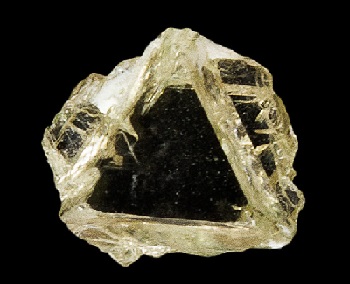
Flat, Twinned Diamond Rough (Macle)
In today’s market, the terms triangular brilliant and triangular modified brilliant are used by GIA in their lab reports to describe unbranded triangle shaped diamonds.
Trilliant cuts typically have shallow depths and this is largely due to the nature of the rough being used. In shaping trilliants, triangular shaped roughs called macles are usually used in order to maximize carat weight retention.
As you can see from the example above, the overall shape and outline of the macle make it a perfect candidate for achieving a triangle shaped polished diamond.
Recommended Proportions For Trilliant Diamonds
Compared to the other fancy cut diamond shapes, the symmetry, polishing and proportions of the trilliant diamond will significantly impact its visual appearance. I recommend a minimum of “very good” ratings for both polish and symmetry.
| Excellent | Very Good | Good | Fair/Poor | |
|---|---|---|---|---|
| Table % | 56% – 66% | 54% – 68% | 52% – 70% | Outside Ranges |
| Depth % | 35% – 46% | 34% – 48% | 33% – 52% | Outside Ranges |
| Polish/Symmetry | Excellent – Very Good | Good | Outside Ranges | |
| Length to Width | 1.00 | 0.95 – 1.05 | 1.10 – 1.20 | Outside Ranges |
| Girdle Thickness | V. Thin – Slightly Thick | V. Thin – Thick | Outside Ranges | |
| Culet Size | None | Very Small | Small | Outside Ranges |
* Note: This table should be used as a reference only. Due to the varying length/width ratio that a diamond may be cut to, there are no hard and fast rules for choosing a diamond based on proportions alone. I don’t recommend buying blind and you should always request additional information like an ASET image or a photograph/video of the diamond.
Pay Attention to Length-to-Width Ratios
A trilliant diamond looks best when it is in the form of an equilateral triangle. Ideally speaking, a 1:1:1 proportion on each side of the diamond is the best. An irregular or out-of-symmetry diamond will be very obvious to the eye and should be avoided.

Tips to Selecting a Nice Modified Triangular Brilliant Cut
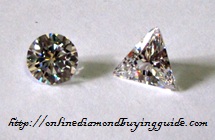
Round cut vs triangular cut diamond comparison.
Trilliant cut diamonds look larger than other shapes for their carat weight because they are cut to shallower depths of around 35 – 46%. While this is an intrinsic property of trilliant diamonds that makes it look bigger, a shallow depth will also result in lesser brilliance and fire.
More importantly, when a shallow cut diamond is dirty, it can accentuate any imperfections within the stone due to the loss of brilliance. As a guideline, I recommend buying trilliants with at least an SI1 clarity.
Note: Trilliant cut diamonds with a depth ratio of less than 35% are often used as side-stones in a ring. If you are choosing a diamond for a solitaire setting, choose a diamond with a depth in the higher limit of 44% to get better fire and brilliance.
Like the marquise and heart shaped diamonds, trilliants also have pointed corners which require extra care to prevent chipping or breakage. Because of this, it is advisable to set them in V-shaped prongs or mountings that provide adequate protection to the sharp corners.
Creative Uses of Trilliant Cut Diamonds in Engagement Ring Designs

There are two main usages for triangular shaped stones when it comes to designing rings. Usually, they are either used as a single diamond in solitaire settings or as accent stones in three-stone settings.
The difference between these two usage types lies in the orientation of the feature stone and both methods have their own advantages. Since trilliants have a single line of symmetry, one side of the diamond should ideally be placed perpendicular to the wearer’s finger.
One of the more popular methods of setting a trilliant cut places the perpendicular side closer to the wearer’s hand and the apex closer to the fingernails. In this orientation, the stone flatters the finger’s length and makes the wearer’s hand more feminine.
When the diamond is installed the other way around – that is, the perpendicular side of the triangle is closer to the nail of the wearer; the result will convey a rather robust appearance. This makes the setup a more comfortable choice for rings, especially those that are designed for men.
Random Orientations of the Center Stone to Fit Unique Tastes
A trilliant cut diamond does not necessarily have to be aligned in an ordered manner. Quite the contrary, the single symmetry can be used in other fancy ways.
When the stone is set up in a random orientation, it will result in a light-some and casual mood. While it is more commonly used for earrings and necklaces, this random alignment can also be used for rings for people who want to be different.
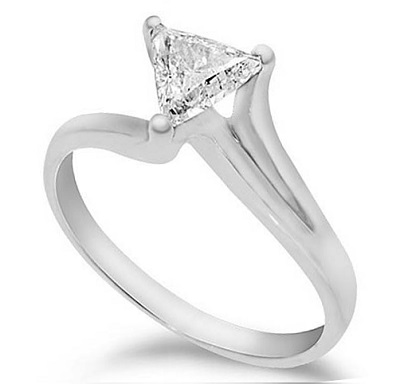
If you are looking for a solitaire diamond ring with a trilliant cut diamond, it would be extremely difficult to find vendors that sell them because of their rarity and low demand.
The best way to get a great looking ring is to work with White Flash for a custom job and allow ample time for completion (2-3 months). This will enable them to source for a great looking stone on your behalf and get it set in a ring of your choice.

Get more details on this ring by clicking on this link…
Trilliant Cut Diamonds as Accent Stones in Engagement Rings
You might want to check out James Allen for some great looking designs. My favorite is the one on the left with the engravings as it gives the ring an authentic Victorian look.
Using Trilliant Shape Diamonds for Earrings
In the case of earrings, the orientation of the diamond has less importance since it won’t be held in place permanently when worn. Instead, the unconventional triangular shape will give the piece of jewelry a playful touch to it.
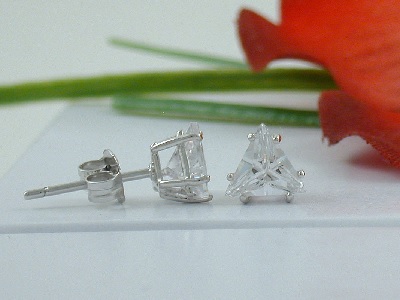
Trilliants Are Also Great For Other Uses of Jewelry
The story does not end here. There is a myriad of other jewelry types which can showcase trilliant cut diamonds. Just to mention one quick example, imagine a halo necklace featuring a trilliant cut diamond with the apex pointing downwards.
Combining this subtle elegance with another diamond shape can yield an epic piece of jewelry.
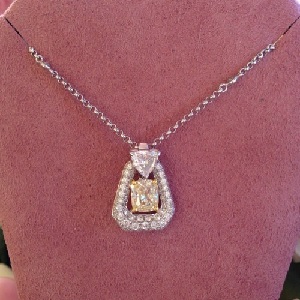
Personally, I find trilliant cuts to be most intriguing when mounted in ring settings because of their unique shape. Ask yourself the following question, how many times had you seen someone wear a trilliant cut diamond ring compared to a traditional round brilliant cut?
Probably never. And if you are someone who wants something truly unique, this can be something you may want to consider.
That said, jewelry preferences vary according to individual tastes. If you love trilliant cuts, don’t be bothered by what other people say about them. To each his/her own; one man’s meat is another man’s poison.
Related Articles
Leave A Comment



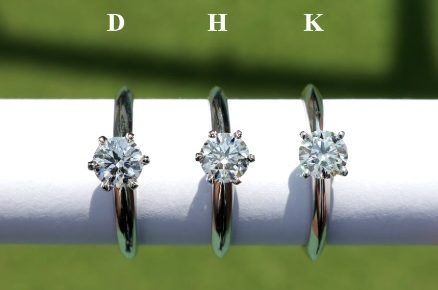
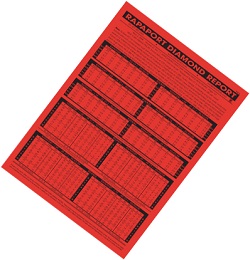
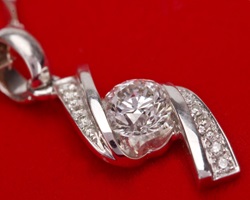










6 Comments
I’m confused between trilliant and trillion cut diamonds? What are the differences between them. I’ve also came across a term called Trillian without a T but the diamond looks just like a triangle shape stone.
Like the Asscher cut, the original trilliant cut was developed by the Asscher brothers from Amsterdam.
It was patented in 1962 and strictly speaking, the term “trilliant cut” should only been used for the patented technique. Having built a successful brand name consumers can associate with, people in the industry started to generalize and labeled triangular shaped diamonds as trilliants.
Ever since the patent held by the Asscher brothers expired, individual companies began to develop modified versions of the original trilliant cut. Branded names like “Trillion” and “Trillian” are all take-offs of the original “Trilliant” cut and you might had come across these terms in today’s market.
So, effectively, all the different terms mean roughly similar things with small variations depending on the branding used. I would say that most straight cut styles are called “Trilliant” and not a Trillian. Larger diamonds usually have slightly curved edges and these are usually Trillians. I hope this helped and hasn’t made things even more confusing for you.
When my wife first saw a trilliant cut diamond, she was in love with them. Upon further research and trying to source for a large solitaire diamond, I realized that they were vastly unpopular. Can you shed any light why?
20 years ago, trilliant cut diamonds were the “in” things in jewelry. Consumers just couldn’t get enough of it and the majority of women can be seen wearing one. And then, something weird happened. Almost overnight, trilliant cuts dropped off the shelves and disappeared into oblivion.
Fast forward to present day, you will be hard pressed to find one in store today. What happened to the aficionados who ravished the triangular shaped diamonds? Why did everybody lose interest in the shape?
Here are my theories on why trilliants died off.
I figured that it would be better to start with a disclaimer as I’m not 100% certain with the causes as well. I do have a couple of educated guesses on why everybody seemed to lose interest. First off, the triangular shape made setting the stone a challenge. The mounting of a ring had to be specially created.
Secondly, the 3 pointed tips of the shape made it vulnerable to chipping and breakage. Not only did the structure posed durability issues to women who handle jewelry roughly, it could also cause discomfort to men. The sharp edges on a ring can actually poke (and puncture skin in serious cases) men who came into contact. Suddenly, the routine of hands holding in couples became a task which required careful thoughts and hand placement to avoid injury.
As you can see, wearing a trilliant cut diamond ring suddenly became a hassle to women. Couple this with the additional troubles that go into making a ring, I speculate these reasons were what led to its downfall in popularity.
Thank you for this article, very informative as usual; I am in the rarity group of loving Trilliant cut diamonds.
I have 2 rings with the trilliant setting, both bezel set, which helps soften the edges, & makes wearing very comfortable
Both stones are not huge, 40 points; but the settings are very usual & beautiful (to me!)
My father, Leon Finker, started cutting brilliant cut triangles in the early 1960s. The Henry Meyer Diamond Company was cutting triangular brilliants back in the late 1960s.
My father had a large diamond cutting factory in New York, and Henry and Irving Meyer used the same diamond cutters as my dad, though their stones were cut slightly different.
Henry Meyer referred to his diamond cut as “Trilliant,” while my father called our cut Trillion.
When I entered the business in the early 1970s, I decided to patent the cut that my father was cutting and trademarked the term “Trillion®” for our patented triangular brilliant.
In 1985 Henry Meyer Diamond Company trademarked only artwork with the word “Trilliant” and never made any claim to the exclusive right to use the term “trilliant” apart from his artwork.
We used the term “Trillion” and “Trillion” in a stylized design until we lost the trademark in 1986 when a federal court judge decided that the words “Trillion” and “Trilliant” were phonetically equivalent. Since trilliant was a concatenation of the generic term “triangular brilliant,” it could no longer be a registered trademark.
We gave the term “trillion” to the trade in a half-page advertisement in the New York Times and announced that our Patented Cut would now be known as Trielle® and TRIELLE® in a stylized design similar to our old trademark.
There was an article, many years ago, in the Rapaport Magazine that had a review of all the special diamond cuts at that time. Both Trillion Cut and Henry Meyers’ Trilliant-Cut were mentioned in that article.
I have attached our original patent and trademark information.
I would appreciate a correction to your website.
Your truly
Marvin